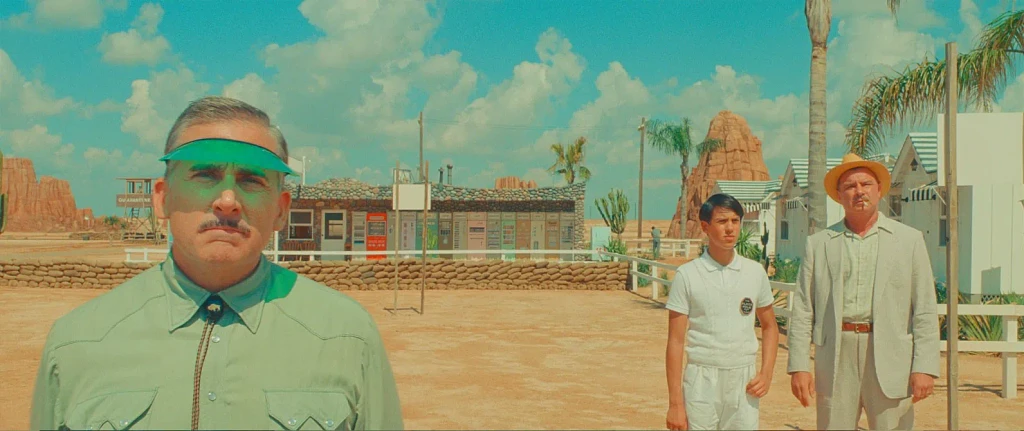
In the world of cinema, few directors possess the unique storytelling prowess of Wes Anderson. His films are known for their eccentric characters, peculiar situations, and often, endings that leave viewers both perplexed and intrigued. In his latest creation, “Asteroid City,” Anderson once again weaves a narrative that defies conventional storytelling. In this article, we will delve into the enigmatic world of “Asteroid City,” offering a comprehensive exploration of its plot, characters, and underlying themes, all while attempting to decipher the peculiarities that make it a true Andersonian masterpiece.
Synopsis Of Asteroid City: A Tale of Two Worlds
“Asteroid City” embarks on a journey unlike any other, entwining two distinct plotlines. On one hand, we have a stage play set in the peculiar desert town of Asteroid City, revolving around a junior Stargazer convention. On the other, a black-and-white TV documentary offers insight into the conception and production of this unconventional play. Yet, neither of these narratives provides a straightforward answer to the film’s central question, leaving viewers to ponder if there is a deeper meaning or if it is merely Anderson’s trademark eccentricity at play.
Meet the Director: Wes Anderson’s Eccentric Genius
Before we delve further into the movie, let’s take a moment to appreciate the man behind the lens. Wes Anderson, known for his meticulous attention to detail and unique visual style, is a director who consistently pushes the boundaries of storytelling. With “Asteroid City,” Anderson continues to demonstrate his ability to craft narratives that challenge conventional norms and leave audiences captivated by their complexity.
Auggie Steenbeck’s Grief: A Central Plot Point
At the heart of “Asteroid City” lies the poignant story of Auggie Steenbeck, portrayed by the talented Jason Schwartzman. Auggie, a recently widowed war photographer, grapples with the loss of his wife and the daunting task of revealing her passing to his four children, three weeks after her death. This film explores how grief can manifest differently in each individual, as Auggie attempts to escape his sorrow through photography and a budding romance with actress Midge Campbell, played by Scarlett Johansson.
Auggie’s journey through grief is a central theme that adds depth to the film. His son, Woodrow, played by Jake Ryan, also grapples with a personal mystery involving an alien encounter, adding layers of complexity to the narrative. As we witness Auggie and his family navigate their individual grieving processes, the film underscores the idea that grief is a deeply personal experience, and each person copes in their own unique way.
The Enigmatic Junior Stargazers
As the film unfolds, viewers are introduced to a multitude of characters, making it a challenging task to keep track of their significance to the overall narrative. One notable line from the movie, spoken by Dina Campbell (Grace Edwards), encapsulates a prevailing theme: “Sometimes I think I feel more at home outside Earth’s atmosphere.” This poignant statement mirrors the feeling of being an outsider, which is further echoed through the junior stargazers, treated like aliens by their own parents and town’s residents. However, within their eccentricities and extravagant inventions, they discover a sense of belonging.
This sense of belonging among the junior stargazers serves as a powerful testament to the theme of finding one’s place in a world that often feels alien. While the film’s characters may appear peculiar and disconnected from the norm, they ultimately find solace and companionship among each other, reminding us that it’s through our differences that we can form the strongest connections.
Quarantine and Transformation
After an alien encounter in Asteroid City, the residents, visitors, and even the junior stargazers find themselves trapped in quarantine, unable to leave. This unexpected turn of events bears an uncanny resemblance to the real-world pandemic experiences we endured a few years ago. While it may not be a direct commentary on the pandemic, it reflects the challenges of coping with the unknown and the inexplicable.
The quarantine, a central plot element, also serves as a catalyst for character transformation. Stanley (Tom Hanks), Auggie’s father-in-law, experiences a profound shift in character during this period. At the onset of the quarantine, Stanley expresses a liking for the desert and aliens, seemingly embracing the situation with an unexpected sense of calm. This transformation reflects the film’s exploration of how individuals adapt to extraordinary circumstances, finding unexpected comfort and belonging in the most unusual of situations.
The Quest for Understanding: Even in the Absurd
Throughout “Asteroid City,” the central theme emerges as a quest for understanding, even when faced with the illogical. The movie, much like Anderson’s other works, challenges us to embrace the inexplicable and find meaning within it. However, it must be said that the execution of this theme leaves room for interpretation and may not provide the clarity some viewers seek.
One of the most meta moments in the film occurs when actor Jones Hall (also portrayed by Jason Schwartzman) confronts the director, Schubert Green (played by Adrian Brody). Hall admits, “I still don’t know what the play is about.” This scene, seemingly acknowledging the confusion, could be interpreted as Anderson’s playful way of engaging with the audience. Yet, it leaves us questioning whether there is a concrete meaning to “Asteroid City.”
The Movie Culture Synopsis
In conclusion, “Asteroid City” proves to be an Andersonian enigma, challenging viewers to grapple with its ambiguity and eccentricity. While it may not offer the same level of clarity as some of Anderson’s previous works, it serves as a thought-provoking exploration of grief, belonging, and the quest for understanding. Whether you’re a die-hard Wes Anderson fan or new to his oeuvre, “Asteroid City” is a cinematic experience that will leave you pondering long after the credits roll.
In the end, the film’s meaning, much like art itself, is open to interpretation. While “Asteroid City” may not provide easy answers, it invites us to embark on a journey of introspection and exploration. So, whether you choose to embrace the challenge or skip this particular flick, one thing is for sure – Wes Anderson’s cinematic wizardry continues to captivate and confound, making him a director like no other.



